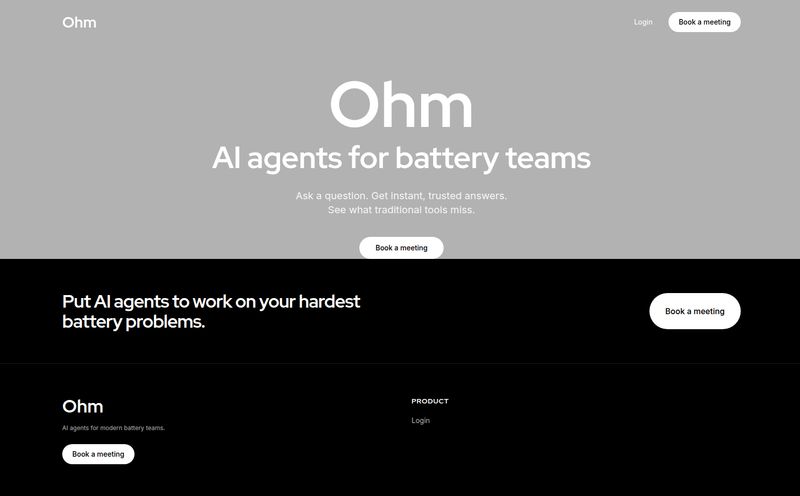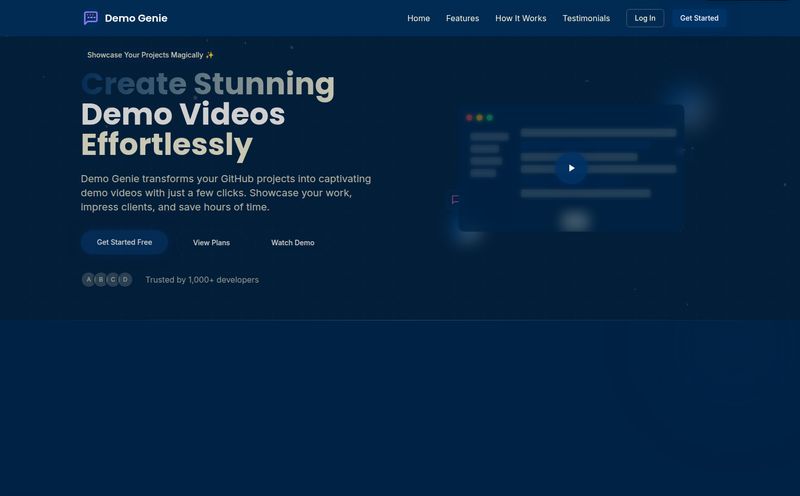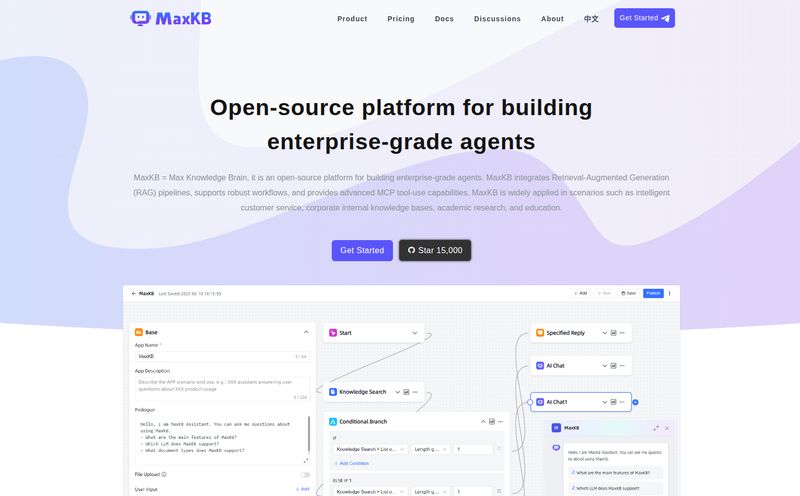We've all been there. Hunched over a screen, debugging a test script that broke because a developer changed a button's CSS class from `btn-primary` to `btn-submit`. It's the soul-crushing reality of traditional test automation. It’s brittle. It's time-consuming. And it often feels like you need a dedicated team of engineers just to maintain the tests, let alone write new ones.
For years, I've watched teams wrestle with this. The promise of automation is huge—faster releases, better quality, lower costs—but the execution can be a nightmare. It’s like being promised a supercar and getting a box of parts with an instruction manual in a language you barely speak. So, whenever a tool comes along claiming to have cracked the code, my skepticism meter goes through the roof. But then I stumbled upon Virtuoso, and well, my interest was piqued.
They’re making some bold claims: 10x faster authoring, 85% reduction in test maintenance... and the ability for non-engineers to write tests. Could this be it? The holy grail of QA?
What Exactly is Virtuoso? (And Why Should You Care?)
At its heart, Virtuoso is a codeless robotic test automation platform. Now, I know "codeless" can be a trigger word for some developers, often associated with clunky, limited tools. But hang with me here. Virtuoso isn't your average drag-and-drop builder. It combines a few really smart technologies: Natural Language Programming (NLP), AI, and Robotic Process Automation (RPA).
Think of it this way. Instead of writing something like cy.get('#email').type('[email protected]'), you literally write in plain English: "Write '[email protected]' in the 'email' field."

Visit Virtuoso QA
The platform’s AI then interprets your command, identifies the correct element on the page, and executes the action. It's designed for any browser-based application, from your standard e-commerce site to complex enterprise software. This fundamentally changes who can participate in the quality assurance process. Your product managers, business analysts, and even manual QA testers can now build and run sophisticated automation suites. That’s not just a small shift; that’s a seismic one.
The Features That Actually Matter
A feature list is just a list until you see how it solves a real problem. Virtuoso has a few standout capabilities that address the biggest headaches in test automation.
Writing Tests in Plain English (Finally!)
The Natural Language Programming is the star of the show. I've seen tools try this before, but often with rigid syntax. Virtuoso feels... different. It's more intuitive. This approach democratizes testing. You're no longer bottlenecked by developer availability to automate a new user story. This means you can “shift left” for real, catching bugs earlier in the cycle because the people who understand the user requirements best can build the tests themselves.
The Magic of Self-Healing Tests
This is the big one. This is the feature that made me sit up and pay attention. Virtuoso claims its tests are self-healing. When a developer changes an element's selector, name, or ID, traditional scripts break. Game over. Go back and fix it. Virtuoso’s AI, however, looks at multiple attributes of an element—its position, its text, its relationship to other elements. If one attribute changes, the AI is smart enough to find the element using other clues. The company claims this slashes test maintenance by up to 85%, and frankly, I believe it. Just think of the cumulative hours your team could get back. It’s mind-boggling.
Beyond the UI: A Full-Spectrum Toolkit
It's not just about clicking buttons and filling forms. A modern app is a complex beast. Virtuoso gets this. It allows you to make API calls directly within your functional tests. You can set up a user via an API call and then test the front-end journey in the same test. It also handles Visual Regression Testing (has the layout changed unexpectedly?), cross-browser testing, and even things like accessibility checks. It’s a surprisingly comprehensive tool that consolidates a bunch of different testing needs into one platform.
The Good, The Bad, and The Pricey: An Honest Look at Virtuoso
No tool is perfect, and it's my job to give you the unvarnished truth. As impressive as Virtuoso is, there are a few things to keep in mind.
The Wins: Where Virtuoso Shines
The upsides are pretty clear and they are substantial. The sheer speed of authoring tests in plain English is a game-changer. The drastic reduction in maintenance thanks to self-healing is probably the single biggest ROI driver. And the ability to empower non-technical team members breaks down silos and can genuinely transform your development culture. The platform being cloud-based also means collaboration is a breeze, with no complex local setups to worry about.
A Few Caveats to Consider
Okay, let's talk about the drawbacks. The biggest one for some teams will be the lack of native mobile app testing. Virtuoso is a master of all things browser-based, but if your primary product is a native iOS or Android app, this isn't the tool for you. Period. Secondly, while it's "codeless," there is a learning curve. You have to learn to trust the AI and understand how it interprets your commands. It's a new way of thinking. And finally, let’s talk about the elephant in the room: the price. This is an enterprise-grade tool, and it's priced accordingly. It’s not going to be a fit for a bootstrapped startup on a shoestring budget.
Let's Talk Money: Virtuoso Pricing Explained
Transparency in pricing is always appreciated, and Virtuoso offers a few different tiers. It can be a little confusing, so let's break it down as simply as possible.
| Plan | Pricing | Best For |
|---|---|---|
| Pay As You Go (PAYG) | Starts at £250 / $124 / €118 | Individuals or small teams needing flexibility and a low-cost entry point. Comes in bundles of executions for up to 3 users. |
| Professional | £500 / $620 / €590 per month | Small teams with consistent testing needs. Includes up to 250 executions per month for up to 5 users. |
| Core | Speak with Sales | Growing teams needing more capacity. Starts with 3 authoring users, 10,000 executions, and dedicated support. |
| Enterprise | Speak with Sales | Large organizations with complex needs. Fully customizable users, executions, SSO, advanced analytics, and more. |
My take? The PAYG and Professional plans are great for dipping your toes in the water or for smaller-scale projects. But the real power and value unlock at the Core and Enterprise levels, where you can fully integrate Virtuoso into your CI/CD pipeline and replace your existing automation frameworks.
My Final Verdict: Who is Virtuoso Really For?
So, is Virtuoso the Selenium killer? For web applications, it makes a ridiculously compelling case. It's not for everyone, but I believe it’s a perfect fit for a few specific groups:
- Enterprise companies with complex, browser-based applications that are a nightmare to test manually.
- Teams drowning in test maintenance who want to reclaim hundreds of developer hours.
- Organizations committed to a true "shift-left" culture that want to empower non-engineers to contribute directly to quality.
If you're a mobile-first company or a tiny team with more time than money, you might want to stick with traditional frameworks for now. But if you fit into one of those buckets above, I genuinely think Virtuoso could change the way you build software. It’s not just an automation tool; it’s a strategy for building better products, faster.
Frequently Asked Questions about Virtuoso
- How do the self-healing tests actually work?
- The AI doesn't just look at one identifier (like an ID or XPath). It analyzes a combination of attributes for each element. When a test runs and can't find an element using its original locator, the AI scans the page for an element that matches the other attributes it has on record, automatically updating the test for the next run.
- Can Virtuoso test more than just the UI?
- Absolutely. While its UI testing is the main attraction, you can run API tests, visual tests, and integrate with other tools to create end-to-end business process tests, all from within the same platform.
- Is Virtuoso a good fit for small teams?
- It can be! With the introduction of their Pay As You Go and Professional plans, it's now much more accessible. If your small team spends a significant amount of time on manual regression for a web app, the cost could easily be justified by the time savings.
- Does Virtuoso work for mobile apps?
- No, not for native mobile apps. It is designed for browser-based applications, which includes testing your website on a mobile browser, but it does not support native iOS or Android app automation at this time.
- What does it mean to write tests in Natural Language?
- It means you write test steps in plain, human-readable English, like "Click on the 'Login' button" or "Look for 'Welcome back, John'". Virtuoso's AI interprets these commands and translates them into actions that a browser can execute.
Closing Thoughts
Look, the world of SEO, traffic, and development is all about efficiency and impact. We're constantly looking for an edge, a way to do more with less. Tools that give us back our most valuable resource—time—are worth their weight in gold. Virtuoso feels like one of those tools. It addresses the most painful parts of the QA process with some seriously impressive technology. It's a bold step forward for test automation, and I, for one, will be watching very closely to see the impact it makes.



